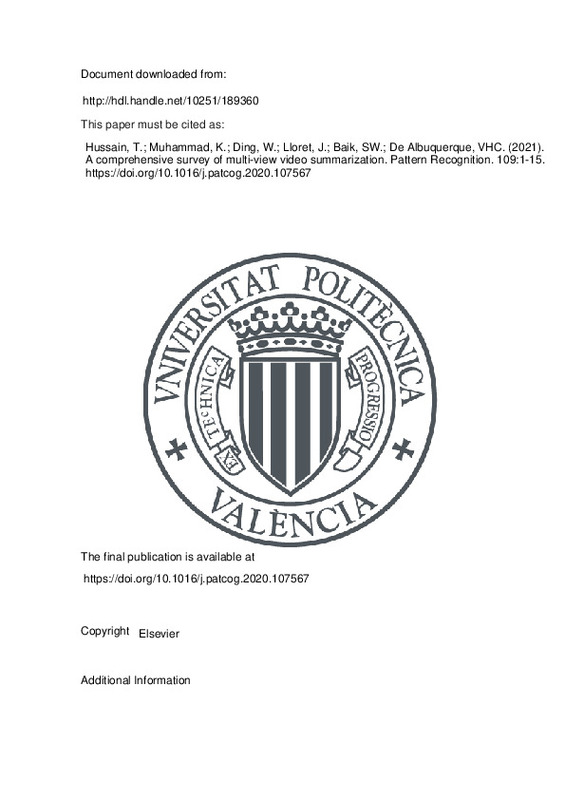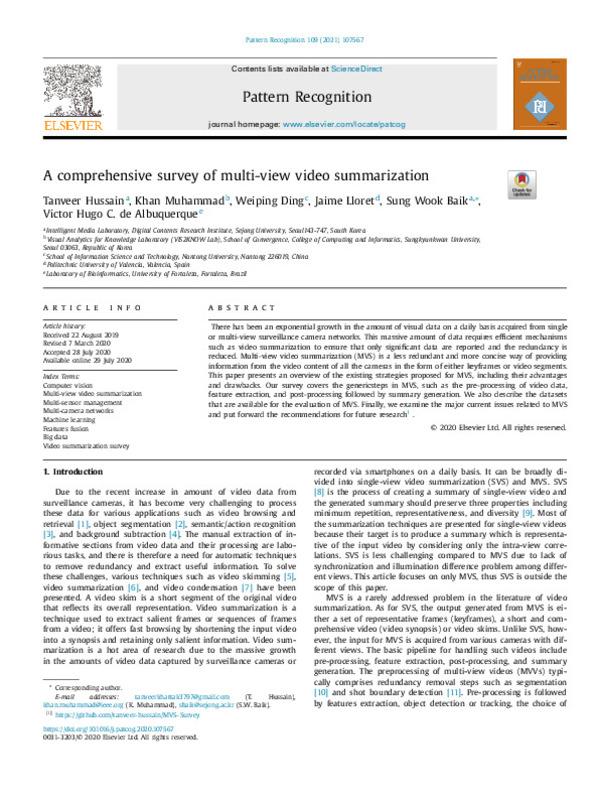JavaScript is disabled for your browser. Some features of this site may not work without it.
Buscar en RiuNet
Listar
Mi cuenta
Estadísticas
Ayuda RiuNet
Admin. UPV
A comprehensive survey of multi-view video summarization
Mostrar el registro sencillo del ítem
Ficheros en el ítem
| dc.contributor.author | Hussain, Tanveer
|
es_ES |
| dc.contributor.author | Muhammad, Khan
|
es_ES |
| dc.contributor.author | Ding, Weiping
|
es_ES |
| dc.contributor.author | Lloret, Jaime
|
es_ES |
| dc.contributor.author | Baik, Sung Wook
|
es_ES |
| dc.contributor.author | de Albuquerque, Victor Hugo C.
|
es_ES |
| dc.date.accessioned | 2022-11-07T16:34:39Z | |
| dc.date.available | 2022-11-07T16:34:39Z | |
| dc.date.issued | 2021-01 | es_ES |
| dc.identifier.issn | 0031-3203 | es_ES |
| dc.identifier.uri | http://hdl.handle.net/10251/189360 | |
| dc.description.abstract | [EN] There has been an exponential growth in the amount of visual data on a daily basis acquired from single or multi-view surveillance camera networks. This massive amount of data requires efficient mechanisms such as video summarization to ensure that only significant data are reported and the redundancy is reduced. Multi-view video summarization (MVS) is a less redundant and more concise way of providing information from the video content of all the cameras in the form of either keyframes or video segments. This paper presents an overview of the existing strategies proposed for MVS, including their advantages and drawbacks. Our survey covers the genericsteps in MVS, such as the pre-processing of video data, feature extraction, and post-processing followed by summary generation. We also describe the datasets that are available for the evaluation of MVS. Finally, we examine the major current issues related to MVS and put forward the recommendations for future research(1). (C) 2020 Elsevier Ltd. All rights reserved. | es_ES |
| dc.description.sponsorship | This work was supported by the National Research Foundation of Korea (NRF) grant funded by the Korea government (MSIT) (No. 2019R1A2B5B01070067) | es_ES |
| dc.language | Inglés | es_ES |
| dc.publisher | Elsevier | es_ES |
| dc.relation.ispartof | Pattern Recognition | es_ES |
| dc.rights | Reconocimiento - No comercial - Sin obra derivada (by-nc-nd) | es_ES |
| dc.subject | Computer vision | es_ES |
| dc.subject | Multi-view video summarization | es_ES |
| dc.subject | Multi-sensor management | es_ES |
| dc.subject | Multi-camera networks | es_ES |
| dc.subject | Machine learning | es_ES |
| dc.subject | Features fusion | es_ES |
| dc.subject | Big data | es_ES |
| dc.subject | Video summarization survey | es_ES |
| dc.title | A comprehensive survey of multi-view video summarization | es_ES |
| dc.type | Artículo | es_ES |
| dc.identifier.doi | 10.1016/j.patcog.2020.107567 | es_ES |
| dc.relation.projectID | info:eu-repo/grantAgreement/NRF//2019R1A2B5B01070067/ | es_ES |
| dc.rights.accessRights | Abierto | es_ES |
| dc.description.bibliographicCitation | Hussain, T.; Muhammad, K.; Ding, W.; Lloret, J.; Baik, SW.; De Albuquerque, VHC. (2021). A comprehensive survey of multi-view video summarization. Pattern Recognition. 109:1-15. https://doi.org/10.1016/j.patcog.2020.107567 | es_ES |
| dc.description.accrualMethod | S | es_ES |
| dc.relation.publisherversion | https://doi.org/10.1016/j.patcog.2020.107567 | es_ES |
| dc.description.upvformatpinicio | 1 | es_ES |
| dc.description.upvformatpfin | 15 | es_ES |
| dc.type.version | info:eu-repo/semantics/publishedVersion | es_ES |
| dc.description.volume | 109 | es_ES |
| dc.relation.pasarela | S\473217 | es_ES |
| dc.contributor.funder | National Research Foundation of Korea | es_ES |









